Class 6 Maths Sample Paper 2026
The CBSE Class 6 Maths sample paper for the academic session 2025-26 is now available for download in PDF format, complete with solutions, on the myCBSEguide app and website. This Ganita Prakash Sample Paper covers all chapters from the new NCERT Class 6 Maths textbook, helping students practice effectively and prepare thoroughly for their exams.
Class 6 Ganita Prakash Sample Paper – 02
Maximum Marks: 80
Time Allowed : 3 hours
General Instructions:
- All questions are compulsory.
- The question paper is divided into four sections:
- Section A:
- 10 Multiple choice questions (1 mark each)
- 5 Fill in the blanks questions (1 mark each)
- 5 True/false questions (1 mark each)
- 5 Very short answer type questions (1 mark each)
- Section B:
- 6 Short answer type A questions (2 marks each)
- 5 Short answer type B questions (3 marks each)
- 4 Long answer type questions (5 marks each)
- Section C:
- 2 Case study based questions (4 marks)
- Section A:
-
Section A
- Choose the correct answers to the questions from the given options.
- The number of lines of symmetry of a kite is
a) 0
b) 2
c) 3
d) 1
- The sides of a rectangle are in the ratio 5:4. If its perimeter is 72 cm, then its length is
a) 30 cm
b) 60 cm
c) 20 cm
d) 40 cm
- In a pictograph, what does one symbol usually represent?
a) A number or quantity
b) A drawing
c) A title
d) A color
- Which angle is larger?
a) 80°
b) 45°
c) 60°
d) 120°
- Which of the following is true about a rhombus?
a) Opposite sides are equal.
b) Diagonals are not equal.
c) All angles are 90°.
d) All sides are equal.
- The number of lines of symmetry of an {tex}n{/tex}-sided regular polygon is
a) {tex}\frac{n}{2}{/tex}
b) {tex}n{/tex}
c) {tex}2 n{/tex}
d) {tex}\frac 3 n{/tex}
- The order of rotational symmetry of an equilateral triangle is
a) 1
b) 3
c) 0
d) 2
- In which of the following expressions, prime factorization has been done?
a) {tex} 56=1 \times 7 \times 2 \times 2 \times 2 {/tex}
b) {tex} 24=2 \times 3 \times 4 {/tex}
c) {tex} 70=2 \times 5 \times 7 {/tex}
d) {tex} 54=2 \times 3 \times 9 {/tex}
- Which graph type is best when you need to compare large data quickly?
a) Pictograph
b) Line graph
c) Bar graph
d) Pie chart
- What is the distance between the center of a circle and any point on the circle called?
a) Diameter
b) Arc
c) Radius
d) Chord
- The number of lines of symmetry of a kite is
- Fill in the blanks:
- A ________ angle measures exactly 90 degrees.
- The smallest prime number is ________.
- When two lines cross each other, they form ________ angles at the point of intersection.
- The big fish weighs {tex}\frac 12{/tex} kg. The small one weighs {tex}\frac 14{/tex} kg. Together they weigh ________ kg.
- A wholesale merchant packed 1 kg of rice in four packets of equal weight. The weight of each packet is ________ kg.
- State whether each of the following statement is True or False:
- If a number divides three numbers exactly, it must divide their sum exactly.
- Kaprekar’s number 6174 can be reached by repeating a certain digit-rearranging process on any 4-digit number.
- A pattern created using only a compass and ruler is considered a form of geometric artwork.
- A semicircle has one line of symmetry.
- When drawing a 40° angle using a protractor, one arm should be aligned with the 0° mark.
- Answer any FIVE of the following questions:
- Coplanar points are the points that are in the same plane. Thus,
- Can 150 points be coplanar?
- Can 3 points be non-coplanar?
- A school ordered 96 chairs and 48 tables. The cost of each chair is `200 and the cost of each table is `150. If the school gave `3500 as an advance, what amount is yet to be paid?
- Add: {tex}\frac{3}{4}+\frac{5}{6}{/tex}
- We are the group of 5-digit numbers between 35,000 and 75,000 such that all of our digits are odd. Who is the largest number in our group? Who is the smallest number in our group? Who among us is the closest to 50,000?
- Find any three numbers that are multiples of 25 but not multiples of 50.

Write down the above 3 marked negative numbers in the following boxes: {tex}\square{/tex} {tex}\square{/tex} {tex}\square{/tex}
- Coplanar points are the points that are in the same plane. Thus,
-
Section B
- Answer any SIX of the following questions:
- In the following figures if the dotted lines represent the lines of symmetry, find the other hole (s).

- Split the following shape into rectangles and find the area. (The measures are given in centimetres).
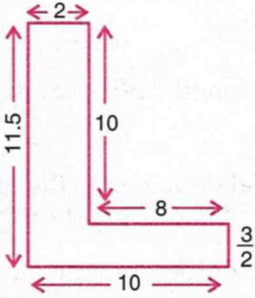
- In a study of number of accidents per day, the observations for 30 days were obtained as follows:
6, 3, 5, 6, 4, 3, 2, 5, 4, 2, 4, 2, 1, 2, 2, 0, 5, 4, 6, 1, 6, 0, 5, 3, 6, 1, 5, 5, 2, 6
Prepare a frequency distribution table. - Look at your watch face. Through how many right angles does the minute-hand moves between {tex}8: 00 \ {O}^{\prime}{/tex} clock and {tex}10: 30 \ {O}^{\prime}{/tex} clock?
- Observe the pattern shown below and write the next two steps:
{tex} 0 \times 9+1 =1 {/tex}
{tex} 1 \times 9+2 =11 {/tex}
{tex} 12 \times 9+3 =111 {/tex}
{tex} 123 \times 9+4 =1111 {/tex} - The distance between Ravi’s house and office is {tex}\frac{11}{3} {~km}{/tex}. He walked a distance of {tex}\frac{2}{3} {~km}{/tex} to catch an auto. He travelled a distance of {tex}\frac{5}{3} {~km}{/tex} before the auto broke down.
- What is the total distance travelled by him?
- How far was he from reaching office?
- How many different 3-digit numbers can be formed by using the digits 0, 2, 5 without repeating any digit in the number?
- In the following figures if the dotted lines represent the lines of symmetry, find the other hole (s).
- Answer any FIVE of the following questions:
- Why is it generally better to try and maintain a positive balance in your bank account? What are circumstances under which it may be worthwhile to temporarily have a negative balance?
- Mark the supercells in the following table:
430 500 350 870 115 795 124 230 580 632 280 446 785 944 805 304 - Discuss the rotational symmetry of a square. Also, determine its lines of symmetry.
- A marble tile measures 10 cm {tex}\times{/tex} 12 cm. How many tiles will be required to cover a wall of size 3 m {tex}\times{/tex} 4 m? Also, find the total cost of the tiles at the rate of ₹ 2 per tile.
- The weights of new born babies (in kg) in a hospital on a particular day are as follows:
2.3, 2.2, 2.1, 2.7, 2.6, 3.0, 2.5, 2.9, 2.8, 3.1, 2.5, 2.8, 2.7, 2.9, 2.4- How many babies weigh below 2.5 kg?
- How many babies weigh more than 2.8 kg?
- How many babies weigh 2.8 kg?
- Look at the figure and name the following:

- A line.
- Four line segments with a common end-point.
- Four rays having same starting points.
- Five points.
- Answer any FOUR of the following questions:
- Write the following mixed numbers as fractions:
- {tex}3 \frac{1}{4}{/tex}
- {tex}7 \frac{2}{3}{/tex}
- {tex} 9 \frac{4}{9}{/tex}
- {tex}3 \frac{1}{6}{/tex}
- {tex}2 \frac{3}{11}{/tex}
- {tex}3 \frac{9}{10}{/tex}
- How does symmetry help in understanding reflections in mirrors?
- The following figures are drawn on a squared paper. Count the number of squares enclosed by each figure and find its area, taking the area of each square as 1 cm2.
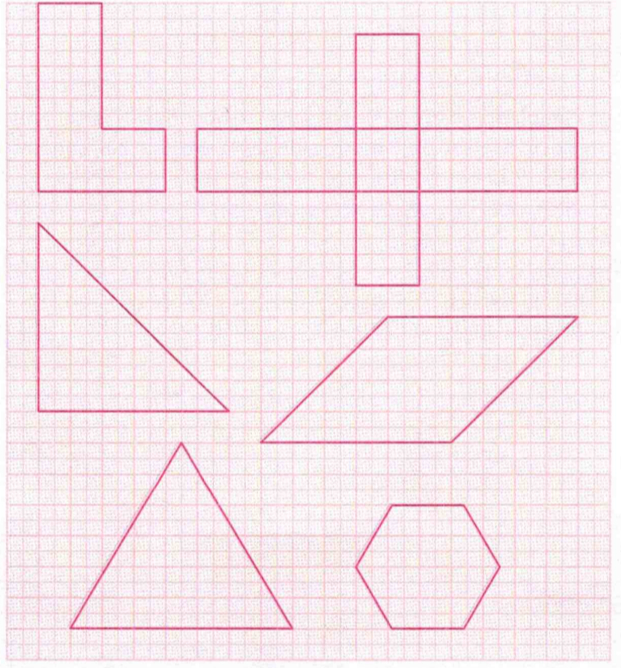
- The following bar graph shows the number of vehicles passing through a road crossing in Delhi in different time intervals on a particular day. Read the bar graph and answer the following questions:
- What does the bar graph represent? Also, give the maximum number of vehicles.
- When is the hourly traffic maximum? Also, give the minimum number of vehicles.
- When is the hourly traffic minimum?
- What is the total number of vehicles passing through a crossing during a particular day?
- How is a line segment different from a line and a ray?
- Write the following mixed numbers as fractions:
-
Section C
- Answer the following Case Study based questions:
- Read the following text carefully and answer the questions that follow:
Anil has {tex}\frac{7}{8}{/tex} of a pizza. He eats {tex}\frac{3}{8}{/tex} of the pizza. He wants to know how much pizza is left. He subtracts the eaten portion from the total: {tex}\frac{7}{8}{/tex} {tex}\frac{3}{8}=\frac{4}{8}=\frac{1}{2}{/tex}. This means {tex}\frac{1}{2}{/tex} of the pizza is left. This helps Anil understand how to subtract fractions and find the remaining portion.- What fraction of the pizza did Anil have initially? (1)
- What fraction of the pizza did Anil eat? (1)
- How much pizza is left after Anil ate his share? Show your work. (2)
OR
If Anil eats another {tex}(\frac{1}{8}){/tex} of the pizza, how much pizza will be left? (2)
- Read the following text carefully and answer the questions that follow:
A palindromic number is a number that reads the same backward as forward. For example, 121 and 1331 are palindromic numbers. These numbers are interesting because they look identical when reversed. Students can practice identifying palindromic numbers by checking if the digits are symmetrical. For instance, 12321 is a palindromic number, while 12345 is not. This concept helps in understanding patterns and symmetry in numbers, which is a fun and engaging way to explore mathematics.- What is the smallest 3-digit palindromic number? (1)
- How many 3-digit palindromic numbers can be formed using the digits 1, 2, 3? (1)
- Find the sum of the smallest and largest 5-digit palindromic numbers. (2)
OR
Explain why the number 12321 is a palindrome. (2)
- Read the following text carefully and answer the questions that follow:
Class 6 Ganita Prakash Sample Paper – 2 (Solution)
-
Section A
- Choose the correct answers to the questions from the given options.
- (d) 1
- (c) 20 cmExplanation:
Consider the sides of the rectangle as {tex}5 x{/tex} and {tex}4 x{/tex}.
We know that, perimeter of rectangle {tex}=2{/tex} (Length + Breadth)
By substituting the values
{tex} 72=2(5 x+4 x) {/tex}
On further calculation
{tex} 72=2 \times 9 x {/tex}
So we get
{tex} 72=18 x {/tex}
By division
{tex} x=72 / 18=4 {/tex}
Hence, the length of the rectangle {tex}=5 x=5 \times 4=20 {~cm}{/tex} - (a) A number or quantityExplanation: Each picture or symbol in a pictograph stands for one or more data values.
- (d) 120°
- (d) All sides are equal.
- (b) {tex}n{/tex}
- (b) 3
- (c) {tex} 70=2 \times 5 \times 7 {/tex}
- (c) Bar graphExplanation: Bar graphs clearly show comparison of large data values.
- (c) Radius
- Fill in the blanks:
- right
- 2
- four
- {tex}\frac 34{/tex}
- {tex}\frac 14{/tex}
- State whether each of the following statements is True or False:
-
True
-
True
-
True
-
True
-
True
-
- Answer any FIVE of the following questions:
-
- Yes
- No
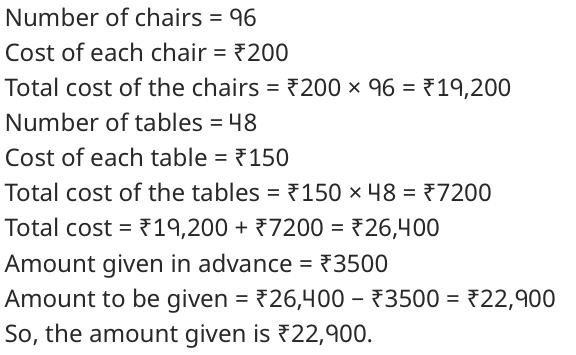
- LCM of 4 and {tex}6=12{/tex}
{tex} \frac{3}{4}=\frac{9}{12}, \frac{5}{6}=\frac{10}{12} {/tex}
{tex} \frac{9}{12}+\frac{10}{12}=\frac{19}{12}{/tex} - The largest number with all odd digits (different) = 73951
The largest number with all odd digits (repetitive) = 73999
The smallest number (non repetitive) = 35,179
The smallest number (repetitive) = 57111
Closest to 50,000 (in case of non-repetition) = 49751
Closest to 50,000 (in case of repetition) = 49999 - Here are three numbers that are multiples of 25 but not multiples of 50:
- 75
- 125
- 175
- -2, -5, and -8 are three negative numbers.
-
-
Section B
- Answer any SIX of the following questions:

- The given figure has two rectangles I and II.
So the area of rectangle I = L {tex}\times{/tex} B = 10 {tex}\times{/tex} 2 = 20 cm2
In the same way area of rectangle II = L {tex}\times{/tex} B = 10 {tex}\times{/tex} 3/2 = 15 cm2
So the total area of the figure = Area of rectangle I + Area of rectangle II
By substituting the values
Total area of the figure = 20 + 15 = 35 cm2
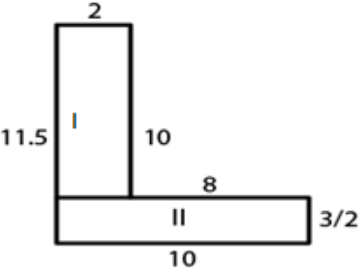
- Frequency table of the given scores:
Scores Tally Marks Number of times 1 {tex}\cancel {||||}{/tex} 5 2 {tex}\cancel {||||}{/tex} 5 3 |||| 4 4 ||| 3 5 |||| 4 6 |||| 4 - Minute hand completes 1 full circle {tex}\left(360^{\circ}\right){/tex} in 60 minutes.
From 8:00 to 10:30 is 2 hours 30 minutes {tex}=150{/tex} minutes.
In 60 minutes, minute hand moves {tex}360^{\circ} \rightarrow 4{/tex} right angles (because {tex}360 \div 90=4{/tex}).
In 150 minutes:
{tex} \text { Number of right angles }=\frac{150}{60} \times 4=10 {/tex} - Look at the pattern:
- Step 1: {tex}0 \times 9+1=1{/tex}
- Step 2: {tex}1 \times 9+2=11{/tex}
- Step 3: {tex}12 \times 9+3=111{/tex}
- Step 4: {tex}123 \times 9+4=1111{/tex}
We see that:
- The number before multiplying by 9 is growing like: {tex}0,1,12,123, \ldots{/tex} (we add the next digit each time)
- The number we add after multiplying by 9 is increasing by {tex}1: 1,2,3,4, \ldots{/tex}
- The answer is all 1 ‘s: {tex}1,11,111,1111, \ldots{/tex}
So, the next two steps are:
- Step 5: {tex}1234 \times 9+5=11111{/tex}
- Step 6: {tex}12345 \times 9+6=111111{/tex}
- Distance walked {tex}=\frac{2}{3} {~km}{/tex}
Distance travelled by auto {tex}=\frac{5}{3}{/tex}
Total distance travelled by Ravi {tex}=\left(\frac{2}{3}+\frac{5}{3}\right) {km}=\left(\frac{2+5}{3}\right) {km}=\frac{7}{3} {~km}{/tex} - Distance between Ravi’s house and office {tex}=\frac{11}{3} {~km}{/tex}
Total distance travelled by Ravi {tex}=\frac{7}{3} {~km}{/tex}
Remaining distance to be covered {tex}=\left(\frac{11}{3}-\frac{7}{3}\right) {km}=\frac{11-7}{3} {~km}=\frac{4}{3} {~km}{/tex}
Hence, Ravi was {tex}\frac{4}{3} {~km}{/tex} away from reaching office.
- Digits: 0, 2, 5
- The first digit can be either 2 or 5 (cannot be 0 because it won’t be a 3-digit number) {tex}\rightarrow{/tex} 2 choices
- The second digit can be chosen from remaining digits {tex}\rightarrow{/tex} 2 choices
- The third digit will be the remaining 1 digit {tex}\rightarrow{/tex} 1 choice
- Total numbers = 2 {tex}\times{/tex} 2 {tex}\times{/tex} 1 = 4
- The 4 numbers are: 205, 250, 502, 520
- Answer any FIVE of the following questions:
- Maintaining a positive balance in your bank account is generally recommended for several reasons:
- Avoid Overdraft Fees: Negative balances often result in overdraft fees, which can significantly reduce your savings.
- Credit Damage: Consistent negative balances can negatively impact your credit score, making it harder to obtain loans or credit cards in the future.
- Peace of Mind: A positive balance provides a sense of financial security and can help you avoid unexpected financial emergencies.
However, there may be circumstances where temporarily having a negative balance is worthwhile:
- Emergency Expenses: In unforeseen situations like medical emergencies or natural disasters, it might be necessary to use funds beyond your available balance to cover immediate expenses.
- Strategic Financial Planning: For some individuals, temporarily going into the negative might be part of a strategic financial plan, such as maximizing investment returns or taking advantage of short-term interest rate fluctuations.
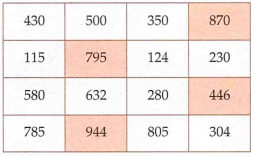
- Let ABCD be a square with centre O as shown in figure. Let us rotate it through 90o, 180o, 270o and 360o about point O to attain various positions shown below.

We observe that the square ABCD fits exactly onto itself. Clearly, after each rotation about point O the square attains the position which exactly fits onto itself. Hence, a square has rotational symmetry of order 4. We have seen that a square has 4 lines of symmetry, namely the diagonals and the lines joining the mid-points of opposite sides. - Measure of marble tile = 10 cm {tex}\times{/tex} 12 cm
Size of the wall = 3 m {tex}\times{/tex} 4 m = 300 cm {tex}\times{/tex} 400 cm
So the area of marble tile = 10 cm {tex}\times{/tex} 12 cm = 120 cm2
Area of wall = 300 cm {tex}\times{/tex} 400 cm = 120000 cm2
No. of tiles required to cover the wall = Area of wall/ Area of one tile
Substituting the values
No. of tiles required to cover the wall = 120000/120 = 1000 tiles
It is given that
Cost of one tile = Rs 2
So the cost of 1000 tiles = 1000 {tex}\times{/tex} 2 = Rs 2000
Hence, 1000 number of tiles are required to cover the wall and the cost is Rs 2000.
- Maintaining a positive balance in your bank account is generally recommended for several reasons:
- Below {tex}2.5 {~kg}: 4{/tex} babies
- More than {tex}2.8 {~kg}: 4{/tex} babies
- Equal to {tex}2.8 {~kg}: 2{/tex} babies
- AD is a line.
- Four line segments are: {tex}\overline{{OA}}, \overline{{OB}}, \overline{{OC}}{/tex} and {tex}\overline{{OD}}{/tex}. Here, the end-point O is common in all four line segments.
- Four rays are: {tex}\overrightarrow{{OA}}, \overrightarrow{{OB}}, \overrightarrow{{OC}}{/tex} and {tex}\overrightarrow{{OD}}{/tex}. Here O is the same starting point.
- {tex}O, A, B, C{/tex}, and {tex}D{/tex} are five points.
- Answer any FOUR of the following questions:
-
- Here {tex}3 \frac{1}{4}=3+\frac{1}{4}{/tex}
[Splitting {tex}3 \frac{1}{4}{/tex} into 3 and {tex}\frac{1}{4}{/tex} ] {tex} =1+1+1+\frac{1}{4} {/tex}
{tex} =\frac{4}{4}+\frac{4}{4}+\frac{4}{4}+\frac{1}{4}=\frac{13}{4} {/tex} - Here {tex}7 \frac{2}{3}=7+\frac{2}{3}{/tex}
[Splitting {tex}7 \frac{2}{3}{/tex} into 7 and {tex}\frac{2}{3}{/tex} ] {tex} =1+1+1+1+1+1+1+\frac{2}{3} {/tex}
{tex} =\frac{3}{3}+\frac{3}{3}+\frac{3}{3}+\frac{3}{3}+\frac{3}{3}+\frac{3}{3}+\frac{3}{3}+\frac{2}{3} {/tex}
{tex} =\frac{23}{3} {/tex} - Here {tex}9 \frac{4}{9}=9+\frac{4}{9}{/tex}
[Splitting {tex}9 \frac{4}{9}{/tex} into 9 and {tex}\frac{4}{9}{/tex} ] {tex} =9 \text { times } \frac{9}{9}+\frac{4}{9} {/tex}
{tex} =\frac{81}{9}+\frac{4}{9}=\frac{85}{9} {/tex} - Here
{tex} 3 \frac{1}{6}=3+\frac{1}{6}{/tex}
[Splitting {tex}3 \frac{1}{6}{/tex} into 3 and {tex}\frac{1}{6}{/tex} ] {tex} =3 \operatorname{times} \frac{6}{6}+\frac{1}{6} {/tex}
{tex} =\frac{18}{6}+\frac{1}{6} {/tex}
{tex} =\frac{19}{6} {/tex} - {tex} \text { We have } 2 \frac{3}{11}=2+\frac{3}{11} {/tex}
{tex} {\left[\text { Splitting } 2 \frac{3}{11} \text { into } 2 \text { and } \frac{3}{11} \text { ] }\right.} {/tex}
{tex} =2 \text { times } \frac{11}{11}+\frac{3}{11} {/tex}
{tex} =\frac{22}{11}+\frac{3}{11} {/tex}
{tex} =\frac{25}{11} {/tex} - {tex} 3 \frac{9}{10}=3+\frac{9}{10} {/tex}
{tex} \text { [Splitting } 3 \frac{9}{10} \text { into } 3 \text { and } \frac{9}{10} \text { ] } {/tex}
{tex} =3 \text { times } \frac{10}{10}+\frac{9}{10} {/tex}
{tex} =\frac{30}{10}+\frac{9}{10}=\frac{39}{10} {/tex}
- Here {tex}3 \frac{1}{4}=3+\frac{1}{4}{/tex}
- Symmetry helps in understanding reflections because mirrors create symmetrical images. When we place an object in front of a mirror, the reflection appears as a symmetrical copy. The reflected image follows the rule that the distance of each point from the mirror remains the same on both sides. This concept is used in periscopes, kaleidoscopes, and optical illusions, making symmetry an essential principle in understanding reflections.
- First figure (L-shaped figure):
Count the full squares inside the figure.
Left vertical part: 3 squares
Bottom horizontal part: 3 squares
Overlap at the corner counted twice, subtract 1 square
Total area = 3 + 3 – 1 = 5 cm2 - Second figure (Cross-shaped figure):
Count squares in each segment:
Middle horizontal segment: 5 squares
Vertical segment: 3 squares (including 1 overlapping in the middle)
Total area = 5 + (3 – 1 overlap) = 5 + 2 = 7 cm2 - Right-angled triangle:
Base = 4 squares
Height = 4 squares
Area = (1/2) {tex}\times{/tex} base {tex}\times{/tex} height = (1/2) {tex}\times{/tex} 4 {tex}\times{/tex} 4 = 8 cm2 - Parallelogram:
Count the base and height:
Base = 5 squares
Height = 3 squares
Area = base {tex}\times{/tex} height = 5 {tex}\times{/tex} 3 = 15 cm2 - Equilateral triangle:
Count squares by visual approximation:
Base = 5 squares
Height = 4 squares (approximate)
Area = (1/2) {tex}\times{/tex} base {tex}\times{/tex} height = (1/2) {tex}\times{/tex} 5 {tex}\times{/tex} 4 = 10 cm2 - Hexagon:
Count squares or approximate:
The hexagon is made of about 6 full squares
Area {tex}\approx{/tex} 6 cm²
- The bar graph represents the number of vehicles passing through a particular crossing of Delhi in different time intervals on a particular day. The maximum number of vehicles is 400.
- The maximum traffic is between 9 to 10 hours. The minimum number of vehicles is 100.
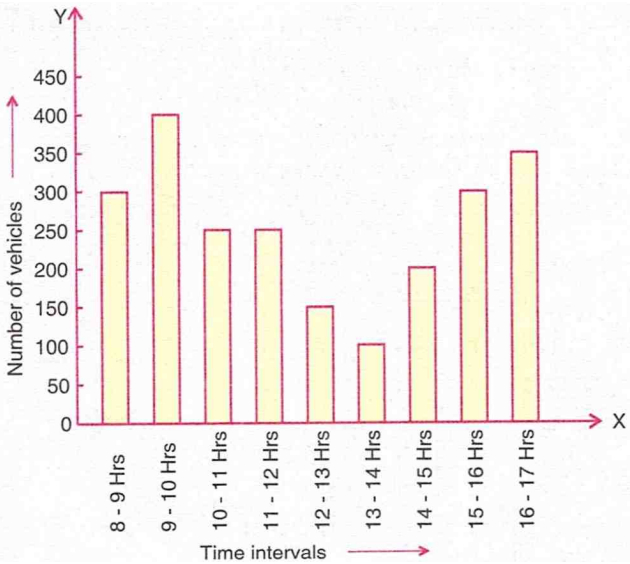
- The minimum traffic is between 13 to 14 hours. The number of vehicles is 100.
- The total number of vehicles passing through a crossing during a particular day = 300 + 400 + 250 + 250 + 150 + 100 + 200 + 325 + 375 = 2350.
- First figure (L-shaped figure):
- A line segment is a straight path with two endpoints. It has a definite length, like the edge of a table. A line, on the other hand, extends infinitely in both directions and has no fixed length. An example is a railway track that appears endless. A ray has one fixed starting point but extends infinitely in one direction, like a torch’s beam. The main difference is that a line segment is limited in length, while a line and a ray extend endlessly.
-
-
Section C
- Answer the following Case Study based questions:
-
- Anil initially had {tex}(\frac{7}{8}){/tex} of the pizza.
- Anil ate {tex}(\frac{3}{8}){/tex} of the pizza.
- The remaining pizza is {tex}(\frac{7}{8} – \frac{3}{8} = \frac{4}{8} = \frac{1}{2}){/tex}.
OR
If Anil eats another {tex}(\frac{1}{8}){/tex}, the remaining pizza will be {tex}(\frac{4}{8} – \frac{1}{8} = \frac{3}{8}){/tex}.
- The smallest 3-digit palindromic number is 101.
- There are 3-digit palindromic numbers that can be formed using the digits 1, 2, 3: 121, 131, and 232.
- The smallest 5-digit palindromic number is 10001, and the largest is 99999. Their sum is 10001 + 99999 = 110000.
OR
The number 12321 is a palindrome because it reads the same backward as forward.
-

Test Generator
Create question paper PDF and online tests with your own name & logo in minutes.
Create Now
Learn8 App
Practice unlimited questions for Entrance tests & government job exams at ₹99 only
Install Now